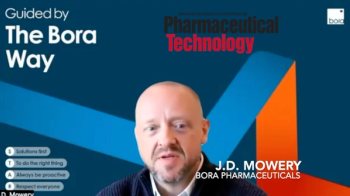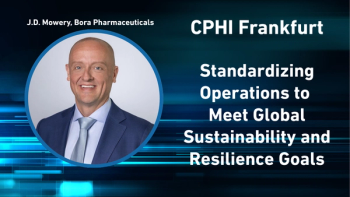
Roughly 80% of Outsourcing Now Strategic, ChemOutsourcing Panelists Agree
Closing the summer of 2015, the ChemOutsourcing conference examined contract services from both a sponsor’s and a CMO or CRO’s perspective
For the past few years, pharmaceutical outsourcing has been moving from a tactical, transactional business to a strategic partnership model. Discussions at the 2015 ChemOutsourcing Conference in September drove home this point.
Breaking the staid pharma event mold, the conference is held from September 17 - 20, the last days of summer, at Oceanside Resort, a hotel in Long Branch, N.J., complete with potted palm trees. Locals report that film studios often use it as a Caribbean standin for movies and TV shows, including The Sopranos.
The program aims to encourage networking and interactions “in the moment,” by featuring interactive panel discussions, rather than individual powerpoint presentations.
For several years, the conference has included the equivalent of speed-dating, three-minute supplier “speed meetings” between prospective business partners. Services and technology vendors not only exhibit but give presentations on their product lines and new focus. This year, it featured a beach bonfire, karaoke night, and simulated rodeo with a mechanical bull.
Attendees say the event’s unusual program and proximity to their business have made it an annual ritual. This year's conference featured a wide range of discussions on topics ranging from scouting new API synthesis routes, to Quality by Design, to contract partner oversight and global industry developments.
One highlight was “Both Sides of the Fence,” a panel discussion offering insights from experts who have worked at both pharmaceutical company sponsors and contract research, development and manufacturing organizations (CROs, CDMOs and CMOs.
Panelists agreed that today, 80% of pharma's CRO, CDMO and CMO business is now built around strategic partnerships. Transactional approaches currently account for about 20% of business, but the move to partnerships continues.
The partnership approach tends to get better results for both sponsor and partner, panelists said. “Those companies that do not engage often don’t get the full value of what a contract partner can bring to the table. Those projects can run into difficulties when customers don’t communicate or engage sufficiently,” said Ray Forslund, senior director of project management at Laurus Synthesis, Inc.
One key issue the panelists brought up was the need to improve project management and handoffs from sponsor to contract partner. “Project managers can muddy the waters if they are the single point of contact,” he noted. “We get out of chemists’ way.” The goal, he said, is to keep them in the lab so that they don’t have to respond to every small issue. “Let chemists focus on chemistry,” he said, noting that this is what he asked for when he was working for a pharmaceutical company. Laurus uses teleconferences and video conferencing to ensure communication with sponsors.
Project management is also focus a key focus for Kalexsyn, a CRO based in Michigan, which bought Pharmacia facilities in Kalamazoo. As Stuart Garmon, director of business development, explained, there are no project managers, per se, and the chief science officer works as overall project manager overseeing all projects. “We focus on direct, scientist-to-scientist interaction,” he said, with a focus on speed and two-way communication. Weekly teleconferences and reports keep both sides connected, he noted.
Any discussion of outsourcing would have to address offshoring, and attendees asked panelists about geographical strategies. “We see that companies are now more open to doing early R&D work in China now,” said Mark Herbert, senior director of business development at WuXi AppTec. Regional focus is becoming less critical, he said, as local companies build up quality reputations. “They are paving the way to an idea that geography doesn’t matter, but, rather, the quality of work.” Generally, he says, as company size increases, so does its comfort with outsourcing overseas.
Tech transfer is a challenge, for sponsors and contract partners alike. “Every client is unique and invidual,” said Laurus’ Forslund. “You want to walk in their footprints and understand what they want. Often, you’re not transferring with them but with one of their business partners, so three-way communication is crucial, as well as understanding and ensuring responsiveness.”
Responding to a question on whether customers demand a quality by design (QbD) approach, panelists suggested that the idea is gaining adherents but isn’t a pre-requisite yet. “It’s not yet fully adopted by industry, and there have been hurdles in getting regulatory authorities to agree on design space issues, so clients may not all be interested in investing in the time and resources required. However, we focus on the essential requirements: critical quality attributes and the formal design space,” said Kalexsyn’s Garmon.
The idea of QbD has been brought earlier into the value chain, to a point where “people are doing it but may not know it,” said Simon Tyler, commercial director of UK-based CatSci Ltd. “Within the past five to ten years it has become a mindset for more people in the industry, and just the way people think.”
Design of Experiments (DOE) is clearly becoming much more important, the panelists said.“It is never too early or late to use DOE,” said CatSci’s Tyler. “Any time you come to manufacturing positions you want to have the best process you can have at the time. Good chemistry and good design are vitally important.”
One audience member asked what panelists had learned now that they wished they might have applied when they were on “the other side.” Each of them stressed the value that working for a pharmaceutical company has for anyone in contract services. “You understand the decisionmaking process in pharma, what key stakeholders are responsible for, how key purchases are authorized, and you oversee large numbers of CMOs and CROs and know what they did well and didn’t do well. It brings insight and knowledge to the table,” said Laurus’ Forslund.
They agreed that communication and dialogue are vital to ensuring that the right questions are asked, and getting the best information. Sponsor companies should make their contract partners feel more like part of their team, said Kalexsyn’s Garmon. “Let them know the importance of the work they are doing for you and your company,” he said, but then, later, he suggested, “Loop back and let them see the impact of their work.”
Pharmaceutical Technology asked conference director Mark Alexay about the Chemoutsourcing event. Alexay, who has graduate degrees in business and international affairs, worked for Pfizer for five years in the early 1990s. After living and working in Colombia for two years, he worked on conference development for SRI for about 10 years, before coming up with the idea of a new conference model.
He saw the need to develop agendas based on broader business issues. Although most attendees are older, senior managers, Alexay says that younger entrepreneurs have a growing presence. Pharma’s biggest challenge today is innovation, Alexay says. “It’s not 1985 anymore, and a lot of the low-hanging fruit has been picked. The question now is how do you discover the next wave of blockbusters?”
In general, this year’s event featured interesting discussions in a different atmosphere. It will be interesting to see what topics are addressed, and how, next year.
Newsletter
Get the essential updates shaping the future of pharma manufacturing and compliance—subscribe today to Pharmaceutical Technology and never miss a breakthrough.





